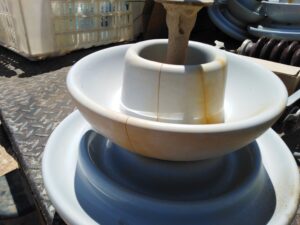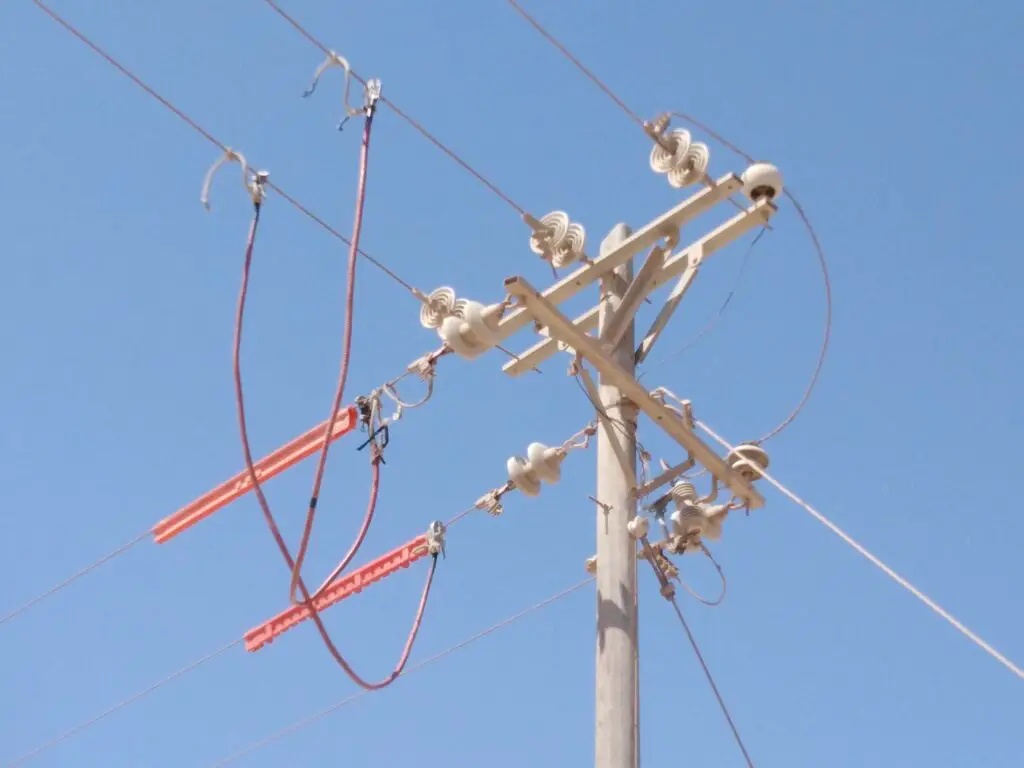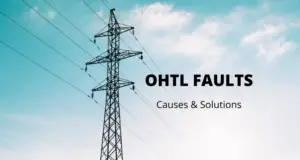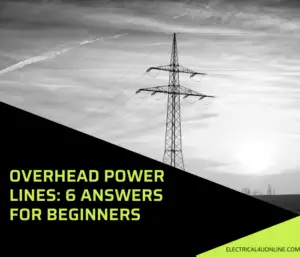OHTL maintenance is one of the major parts in my work. We are responsible for maintenance of 11KV overhead power line.
We do all our maintenance with power off, when it comes to live maintenance, we hire a qualified team to do it for us.
In this article I will answer some important questions about overhead transmission line (OHTL) maintenance.
Table of Contents
What is transmission line maintenance?
The process of replacement damage insulators, periodic inspection and repair the Overhead Transmission lines towers, conductors and accessories is called the transmission line maintenance.
This process includes insulators cleaning, joints tightening and hot spots clearing.
As the overhead transmission line comprise of three main components i.e., conductor, insulator, and the towers (and the supporting materials), the process also refers to the replacement of electric equipment used in the overhead transmission lines.

This equipment includes the broken insulators, worn-out cables and the wooden cross-arms.
A checkup of the foundation of every tower, its earthing, power conductor and earth wire conductor is also done.
A calculation based on corona effect is also performed.
The dust and dirt on the transformers bushings may lead to flash-over and poor efficiency of the system of power transmission. So, cleaning transformers is also an essential part of the OHTL maintenance.
Now, let’s move to another question and discuss OHTL maintenance types.
What is transmission line maintenance types?
There are 2 types for the maintenance of transmission lines.
- Cold Line maintenance
- Hot Line maintenance
The cold line maintenance has another name i.e., “In-Operative Method” of transmission line maintenance.
While the hot line maintenance is also known as “line-in Operation” of maintenance of transmission lines.
To choose one of these options, the guidelines have been issued by Institute of Electrical and Electronics Engineering (IEEE).
You should have the knowledge of voltage levels, that is being transmitted by the line, before choosing one of these options for maintenance types.
We use cold maintenance in my workplace for short period non periodic maintenance, when the cost of down time is not high.
While the company prefers live maintenance for long period regular maintenance, while the cost of stopping loads will be costly.
In my workplace
Overhead Transmission line maintenance procedure
In the transmission line maintenance work we do replacement of burnt jumpers, insulators, maintaining the ground clearances, replacements of damaged poles, re-stringing of the cables and line patrolling.
As a short procedure list :
- Prepare all work permits from the authorized departments.
- Prepare a good work plane with all details and parts that need maintenance.
- Make sure that the all crew members know their rule and what they are expected to do.
- Check all hand tools, PPE equipment, and all trucks and vehicle.
- Make a pre-work meeting to discuss all points with the team to make every thing clear, specially safety precautions.
- If the work is cold maintenance, check and double check power isolation procedure before work.
- Recheck power with test tools.
- Make sure to use grounding rods and cables for all lines to protect the workers from any unexpected power connection.
- Go ahead with great caution and make sure that only qualified workers are involved in the job.
- After completing all tasks as planned, never ever connect power before direct contact with all members to ensure that no body still on the towers.
- Connect power and check loads.
OHTL maintenance tasks
- Ground Inspection: The first step of maintenance is ground inspection of the cables and towers. The surveyor walks along the transmission lines and checks if the line is cut or not.
- The tower foundation, nut-bolts, beam, cross-arms, waist, main legs, horizontal and diagonal members are checked. The anti-climbing parts of towers are set if damaged.
- The nut-bolts are replaced if hey become useless.
- The insulators and vibration dampers should be also checked.
- If the tower body is damaged, on the basis of the magnitude of damage, it is either replaced or repaired.
- Insulators inspection is carried out. The insulators are checked to make sure that there is no damage is done to them by flashover events or if they are broken or contaminated.
- The sag between two poles is also measured to see if the line between the poles has loosened or not.
- Conductor condition and spacing from the adjacent conductor is checked.
- Corona Inspection: Corona can be really catastrophic in the overhead line transmission system. The detection of corona is carried out by the “Thermal Vision Scanning”. In corona, a reasonable amount of heat is emitted. So, the thermal vision scanner is the instrument used to detect the heat coming from the cables and the joints.
In all of these methods the crew is completely insulated from the live lines using different materials except for the bare-handed procedure.
In bare-handed procedure, the crew members are on the same potential as the line is. There is a reasonable distance of the line from the ground.
So, there is no worrying of completing a circuit that could harm the line man. In the others methods, the crew members wear the insulating suits that is a complete shield from the electric field, potential and absolute potential.
What does a live power line mean?
The energized line of the overhead transmission system is called a live power line. Energized means the power in the cable is present.
A live power line has no visual signs that you can count on to know if the line is energized or not.
A rule of thumb is , “If you don’t know, its energized” i.e if you are about to work on a power line, you should suppose it’s energized unless you are 100% sure its not a live line.
I usually use a medium voltage tester or a medium voltage multimeter to check the power line.
What does OHTL live maintenance Mean?

Live power line maintenance means, inspecting and repairing the transmission lines while the power is not isolated.
For this kind of maintenance, the system is not shut down and the line has a live voltage.
Conductors and insulators are checked, repaired, and replaced if required, without de-energizing the line. It is also known as Hot-line maintenance.
Why to use Live maintenance?
The main reason for using this process is not to interrupt the power transmission by the power lines to keep loads working.
This method is suitable for critical loads, and loads that cost much if stopped.
If the lines are de-energized, the end systems are affected because power is not being supplied continuously.
Live line maintenance is a successful method that is applicable for any kind of live lines ranging from the Low Voltage live lines (69 kV) to Ultra High Voltage live lines (1 MV).
process of live line maintenance methods:
- Bare-hand method
- Insulating gloves
- Hot Stick
Bare-hand Method
In Bare-hand method that is also known as the Potential method. The worker has the same potential as the line has. He comes in direct contact with the line.
Workers may stand/sit on the line or choose to stand on a platform suspended from the line or a separate platform of the same potential.
To access the line, the worker is provided one of these facilities.
- A platform of the helicopter is maintained at the same height as the line. It is an expensive way to maintain to the power line.
- An insulated ladder that can move back and forth along the line.
- A mobile elevating work platform or an IAD (insulating aerial device) is provided. Bothare insulated.
- The worker may be hanged through the helicopter to reach the line level.
When using a platform, the worker must take care of the arc forming while energizing himself to the level of the cable.
For this purpose, a wire or a wand can be used to make an electric bond to prevent more arcing that may lead to damage. This step zeroes out the probability of current running through the body of the worker.
Reverse the process after completion of maintenance. Remove the worker from the line and the IAD is closed down.
Insulating Gloves method
In this method, the worker is covered with an insulating suit, after wearing the insulating suit, he is allowed to work on the line using his hands covered with the rubber or insulating material. Note that the worker should be isolated from contacting any grounded parts and tools.
The worker must be aware of the type of insulator that is needed for maintenance. On the basis of the magnitude of the voltage, gloves are classified into some classes.
- Class-00: These gloves are used for low voltages. Usually, the line voltage up to 500 V can be dealt with easily using these gloves. It has Beige color.
- Class-0: These gloves are used for dealing voltages ranging from up to 1kV. This class is red in color.
- Class-1: These gloves are better than class 0, have a voltage dealing capacity ranging from up to 7.5kV. This category is painted white.
- Class-2: These gloves are used for dealing voltages up to 17kV. The color it is painted is yellow.
- Class-3: Voltage that has a magnitude of 26kV is dealt with the class 3 insulating gloves. These gloves are green in color.
- Class-4: The voltage of magnitude 36 kV is dealt with class 4 insulators and they are painted with orange color.
(The voltages in the above section are the line-to-line voltages)
Hot Stick Method
The hot stick method is carried out using a pole. This pole is generally made of the fiberglass and as it is a fiberglass it is an insulator.
This pole is used to make it sure that the lineman is out of danger. This method is carried out while the line is energized.
The pole plays its role to open/close switch, lay insulating sleeves, test the voltage of the line, replace the fuses and some other tasks depending on the nature of task needed to be performed.
Who can perform live OHTL maintenance?
The linemen of the particular department of power distributions of a country perform the live overhead transmission line maintenance. The lineman must have some skills like:
- Proper knowledge of OHTL.
- Proper knowledge of insulators, vibration-dampers, conductors.
- Know how to operate the IAD (insulating aerial device).
- The method that is to be used at the particular voltage of the line.
- Experience of maintenance by himself or the experience of maintenance under the supervision of a senior.
Advantages/Disadvantages of maintenance OHTL
| Advantages | Disadvantages |
| The maintenance may add up to 40-50 years in the age of the lines. | High cost, specially live maintenance |
| The risk of losses decreases. | High risk tasks, including: working at height and electrocution risk |
| The risk of interruption of power is lesser than the non-maintained lines. | Needs long time to make maintenance for all lines |
| Power losses such as corona losses can be checked and we can get rid of them. |
How do you know if a power line is live or not?
Without testing you can’t tell if the power line is energized or isolated.
If you have no testing equipment, you should suppose the line as energized.
There are different ways to tell whether the line is live or not using the voltage testers.
- HVNCVT-1: for the voltage from 50V to 1.5kV.
- HVNCVT-2: for the voltage from 1.5kV to 1.32MV.
These non-contact voltage testers are attached to the fiberglass pole and have a knob to select the range.


